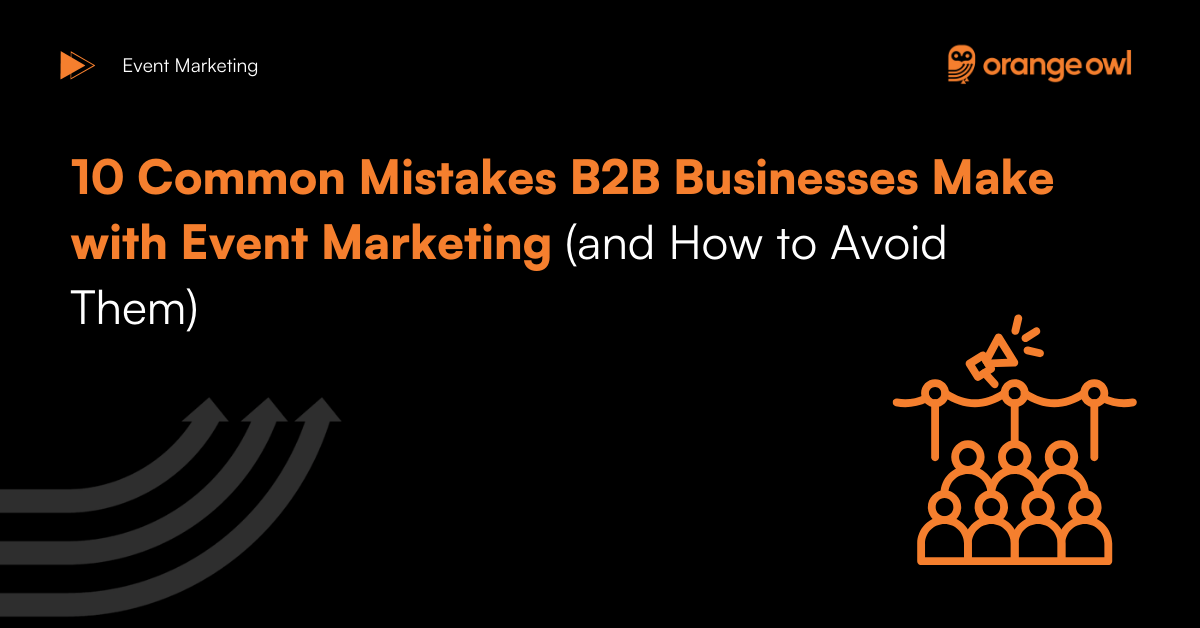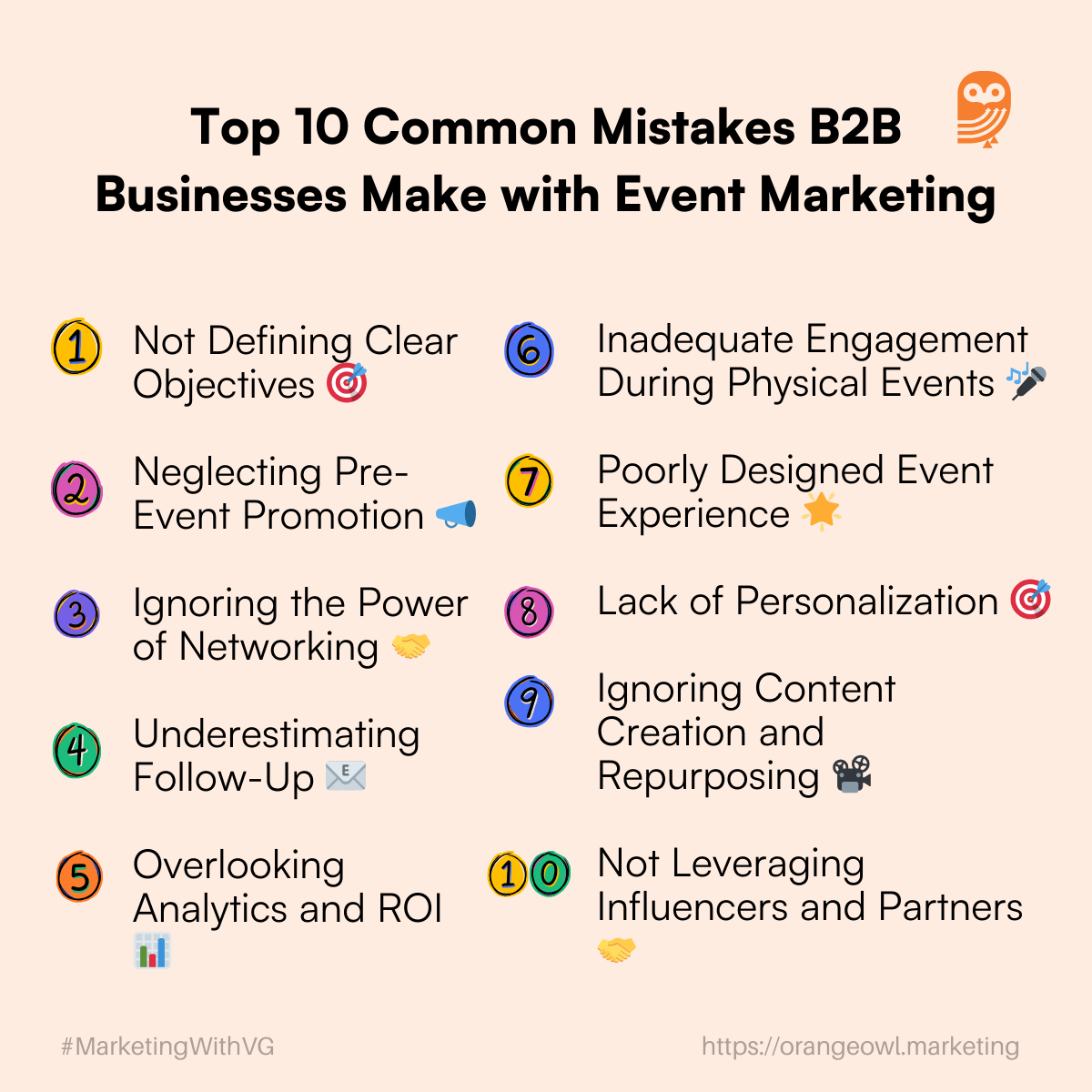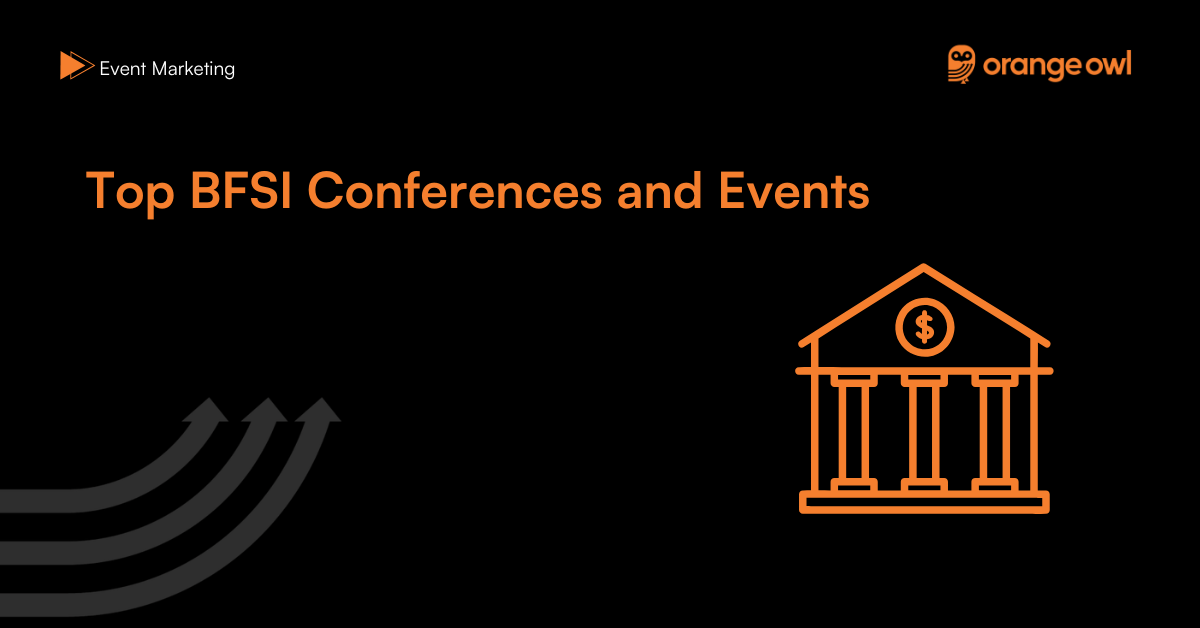10 Common Mistakes B2B Businesses Make with Event Marketing
Ricky Davis
August 1, 2024

Table of Contents
Event marketing can be a game-changer for B2B Marketing, offering opportunities to build relationships, generate leads, and enhance brand awareness. However, many businesses fall into common traps that can undermine their efforts. Here are ten common mistakes B2B marketers often make with event marketing and how to avoid them.
10 Common Mistakes B2B Businesses Make with Event Marketing (and How to Avoid Them)
Mistake 1: Not Defining Clear Objectives 🎯
Mistake:
Jumping into event planning without specific, measurable goals.
Example:
A software company hosts a trade show booth but fails to set objectives beyond “showing up.” This results in a lack of focus and unclear metrics for success.
Solution:
Set clear objectives from the start, such as lead generation, brand awareness, or customer engagement. Ensure these goals are specific, measurable, achievable, relevant, and time-bound (SMART).
Expert Tip:
Document your goals and share them with your team to ensure alignment and focus. Regularly review these goals to stay on track and make adjustments as needed.
Detailed Example:
Consider a cybersecurity firm planning to exhibit at an industry conference. By setting a goal to generate 100 qualified leads, they can tailor their booth activities, marketing materials, and staffing decisions to achieve this target. They can measure success by tracking lead capture forms and post-event follow-up engagement.
Mistake 2. Neglecting Pre-Event Promotion 📣
Mistake:
Relying solely on the event day to attract attendees.
Example:
A B2B SaaS provider sends out event invitations just a week before the event, resulting in low attendance due to insufficient promotion time.
Solution:
Start promoting your event early through email campaigns, social media, and partnerships to build anticipation and ensure a good turnout.
Expert Tip:
Create a content calendar for pre-event promotion, including blogs, emails, and social media posts. Engage with potential attendees through interactive content such as polls and Q&A sessions.
Detailed Example:
An enterprise resource planning (ERP) solution provider begins promoting their annual user conference three months in advance. They use a mix of email newsletters, LinkedIn posts, and webinars to generate interest. By the time the event arrives, they have a waiting list of attendees eager to participate.

Mistake 3. Ignoring the Power of Networking 🤝
Mistake:
Focusing only on the presentations and neglecting networking opportunities.
Example:
An IT solutions company organizes a conference but doesn’t provide any breaks or networking sessions, missing the chance for attendees to connect.
Solution:
Facilitate networking by creating dedicated spaces and times for attendees to connect. Use event apps to help them find and interact with each other.
Expert Tip:
Encourage speakers and panelists to mingle with attendees during networking sessions. Consider hosting themed networking events, such as industry roundtables or speed networking.
Detailed Example:
A financial services firm hosts a conference and includes multiple networking breaks, a cocktail hour, and an exclusive dinner for VIP guests. They also use a mobile app that allows attendees to schedule one-on-one meetings, enhancing networking opportunities and building lasting business relationships.
Mistake 4. Underestimating Follow-Up 📧
Mistake:
Failing to follow up with attendees after the event.
Example:
A marketing agency hosts a webinar but doesn’t send follow-up emails, missing the opportunity to nurture leads and convert them into clients.
Solution:
Have a post-event follow-up plan in place, including thank-you emails, surveys, and additional content to keep the conversation going.
Expert Tip:
Segment your follow-up emails based on attendee behavior and interests shown during the event. Personalize your messages to address specific topics discussed.
Detailed Example:
A digital marketing firm conducts a workshop on SEO strategies. After the event, they send personalized follow-up emails with a summary of key takeaways, a link to download the presentation slides, and an invitation to schedule a free consultation. This approach results in higher engagement and leads conversion.
Mistake 5. Overlooking Analytics and ROI 📊
Mistake:
Not measuring the success of the event beyond attendance numbers.
Example:
A B2B consultancy firm tracks only the number of attendees and misses out on analyzing lead quality and conversion rates, resulting in an incomplete assessment of the event’s success.
Solution:
Track metrics like engagement, lead quality, and conversion rates to assess the event’s impact and inform future strategies.
Expert Tip:
Use tools like Google Analytics and CRM systems to integrate and analyze event data. Set up specific KPIs to measure before, during, and after the event.
Detailed Example:
A SaaS company hosts a user conference and tracks various metrics such as session attendance, engagement in live polls, social media mentions, and post-event survey responses. They use this data to determine which topics resonated most with attendees and to improve future events.
Mistake 6. Inadequate Engagement During Physical Events 🎤
Mistake:
A common mistake B2B tech companies make is setting up a barebones stall at tech events with only brochures and minimal interaction. This lack of engagement fails to capture the interest of attendees and potential leads, resulting in missed opportunities.
Example:
Imagine a B2B tech company attending a major industry conference. They set up a small booth with a table, some brochures, and a single staff member who occasionally answers questions. Passersby glance at the booth but rarely stop, and those who do leave quickly after picking up a brochure. The company receives very few leads and fails to make a significant impact at the event.
Solution:
To maximize engagement, B2B tech companies should create an interactive and welcoming booth environment. This includes setting up contests, games, and giveaways to attract attendees. Additionally, having a designated meeting area for VIPs and target customers, complete with snacks, a coffee or cocktail bar, and a demo setup, can significantly enhance engagement.
Detailed Example:
At the next tech conference, the same B2B tech company implements the following strategies to engage attendees effectively:
- Interactive Booth Activities: They set up a quiz game related to their tech solutions, with small prizes for participants. This draws in attendees who are curious and want to participate in the fun.
- Giveaways and Merchandise: Branded items like USB drives, tote bags, and notepads are given away. These items are practical, ensuring attendees remember the company long after the event.
- Meeting Areas: A comfortable, semi-private area within the booth is set up for one-on-one meetings with special guests and ideal leads. This space includes comfortable seating, a coffee bar, and light snacks, creating a relaxed environment for discussions.
- Demo Stations: Several stations with live demos of their products are set up. Trained staff conduct these demos, allowing attendees to see the technology in action and ask questions on the spot.
- Snacks and Beverages: A small bar area within the booth offers coffee during the day and cocktails in the evening, inviting attendees to linger and engage in conversations.
- Photo Opportunities: A photo booth with the company’s branding is set up, allowing attendees to take fun pictures. These photos can be shared on social media, increasing the company’s visibility.
Expert Tip:
- Leverage Event Apps: Use event apps to schedule meetings and notify attendees of your booth activities. This helps in managing the flow and ensuring key prospects are engaged effectively.
- Engage Staff: Train booth staff to be proactive in engaging with attendees. Friendly, knowledgeable representatives can make a significant difference in attracting and retaining interest.
By creating an engaging and interactive booth environment, the B2B tech company not only attracts more attendees but also facilitates meaningful interactions that lead to valuable business connections. This approach ensures they stand out at the event and maximize their return on investment.
Mistake 7. Poorly Designed Event Experience 🌟
Mistake:
Failing to create a cohesive and enjoyable event experience.
Example:
A financial services company hosts a conference with disjointed sessions and poor time management, leading to a chaotic experience for attendees.
Solution:
Plan every detail of the event experience, from registration to post-event follow-up, ensuring a seamless journey for attendees.
Expert Tip:
Gather feedback from past events to continually improve the attendee experience. Use event management software to streamline logistics and communication.
Detailed Example:
An HR solutions provider hosts an annual summit and invests in creating a seamless experience from start to finish. They provide clear signage, a user-friendly event app, and efficient registration processes. Attendees receive personalized schedules and regular updates, ensuring a smooth and enjoyable event experience.
Mistake 8. Lack of Personalization 🎯
Mistake:
Sending generic invitations and communications to all attendees.
Example:
A B2B software company sends the same email to both potential clients and existing customers, missing the opportunity to tailor their message to different segments.
Solution:
Personalize your communications based on attendee segments, addressing their specific needs and interests.
Expert Tip:
Use marketing automation tools to segment your audience and deliver personalized content. Collect data on attendees’ preferences and behaviors to tailor your messaging.
Detailed Example:
A marketing automation platform hosts a webinar series and segments their email list based on industry, company size, and role. They send personalized invitations highlighting relevant content and case studies, resulting in higher registration and engagement rates.
Mistake 9. Ignoring Content Creation and Repurposing 📽️
Mistake:
Not creating content from the event or repurposing it for future use.
Example:
A digital marketing firm hosts a successful workshop but doesn’t record the sessions or create follow-up content, missing the opportunity to extend the event’s reach.
Solution:
Record sessions, take photos, and create written summaries to repurpose for blogs, social media, and future marketing materials.
Expert Tip:
Plan your content strategy before the event to ensure you capture valuable content during the event. Share highlights and key takeaways on social media in real-time to engage a broader audience.
Detailed Example:
An enterprise software company records all sessions from their annual user conference. They create blog posts, social media snippets, and an eBook from the recorded content, reaching a wider audience and generating leads long after the event.
Miskate 10. Not Leveraging Influencers and Partners 🤝
Mistake:
Failing to collaborate with industry influencers and partners to amplify the event’s reach.
Example:
A tech startup hosts a product launch event without involving key industry influencers, limiting their audience reach and potential impact.
Solution:
Collaborate with industry influencers and partners to co-promote the event and enhance credibility and reach.
Expert Tip:
Offer influencers and partners special roles at the event, such as panelists or keynote speakers, to incentivize their participation. Provide them with exclusive content and early access to event materials.
Detailed Example:
A B2B fintech company partners with industry influencers to co-host a webinar series. Influencers share their expertise and promote the event to their followers, significantly increasing attendance and engagement. The company also collaborates with complementary businesses to cross-promote the event, reaching a broader audience.
Conclusion
Avoiding these common pitfalls can significantly enhance the success of your B2B event marketing efforts in your GTM execution strategy. By setting clear objectives, promoting early, engaging your audience, and leveraging analytics, you can create impactful events that drive business growth. Remember, the key to successful event marketing lies in meticulous planning, execution, and continuous improvement based on feedback and data.


